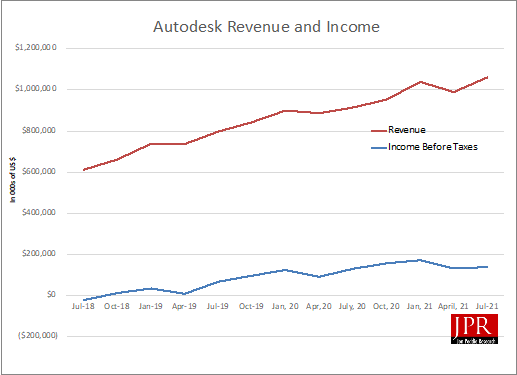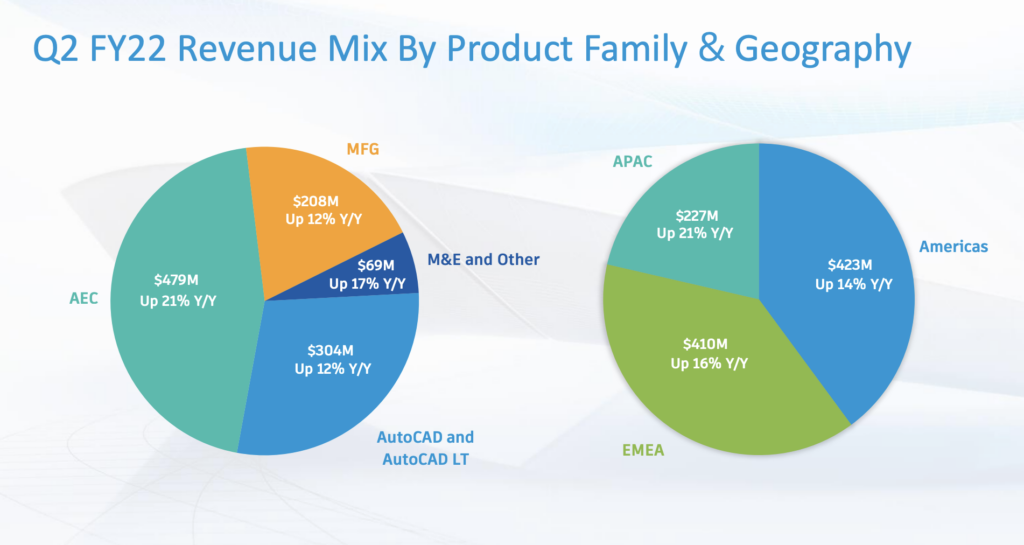Subscription growth and tough love on licensing deals enable a 16% increase in revenues.
Autodesk CFO Debbie Clifford described Autodesk’s financial results as strong, and that they were and that they have been. In his introductory comments, CEO Andrew Anagnost said the company offered its guidance at the start of 2021 during a period of “unwinding uncertainty,” which does communicate the bit of suspense that has accompanied the journey through Spring 2021. Nothing today is business as usual, but business for Autodesk has been pretty good as the company’s drive to automate construction is yielding results. Ongoing subscription business and Autodesk’s various efforts to extract better terms for software and services as well as enforcing license compliance are helping the company maintain a steady financial base.
Significantly, Autodesk is also transitioning more of its customers to direct sales rather than from traditional channels. Clifford said direct revenue has increased 31% and now represents 34% of Autodesk’s total revenue. It was 30% last year. She says that about three quarters of new customers are coming to Autodesk through digital channels, thanks to a simplified buying experience.

Just the numbers, please
- Total revenue increased 16% to $1,060 million; the company’s net income was $115.6 million, an 18% increase year over year.
- Total billings increased 29% to $1,015 million.
- Net revenue retention rate was within the range of 100–110%.
- GAAP operating margin was 14%, down 2 percentage points.
- Non-GAAP operating margin was up 2 percentage points to 31%.
- GAAP diluted EPS was $0.52; Non-GAAP diluted EPS was $1.21.
- Cash flow from operating activities was $202 million; free cash flow was $186 million.
CEO Andrew Anagnost celebrated the company’s successful quarter saying, “sustained and purposeful innovation to enable digital transformation in the industries we serve is changing our relationship with our customers from software vendor to strategic partner.”
Both Clifford and Anagnost talked about how the company’s progress so far is enabling changes in their benefit that will inevitably benefit customers including an end-to-end, cloud-based solution that connects data and workflows. Anagnost said that he’s talking up the coming Flex option for occasional customers who want to pay for only the amount of software they use. He said that “ratable” licenses are coming in 2022. Anagnost is confident that the digitalization trend along with increased transparency is beneficial for both sides: “by helping our customers grow, we will grow too, giving us confidence in our FY 23 goals and beyond.” So far the company has had no trouble hitting its marks and investors are benefitting along with everyone else.
CFO Debbie Clifford said, “robust growth in new product subscriptions, accelerating digital sales, and improving subscription renewal rates drove our strong second-quarter results.” As a result, Clifford says Autodesk is raising its guidance for FY22 (we’ll provide Autodesk’s estimates later on in this article).
The company will also be tinkering with the deals they have with EBA customers. The company has multi-year deals with some companies on an EBA basis (enterprise business agreements). The company is planning to transition those customers from multi-year paid upfront to annual billings. They’re confident that most customers will go for the deal because they’ll have better transparency into their costs.
Just some more numbers, please
- Design revenue was $944 million, an increase of 15% as reported, and 13% on a constant currency basis. On a sequential basis, Design revenue increased 7% as reported, and 6% on a constant currency basis.
- Make revenue was $90 million, an increase of 26% as reported, and 25% on a constant currency basis. On a sequential basis, Make revenue increased 10% as reported, and 9% on a constant currency basis.

- Subscription plan revenue was $1,017 million, an increase of 21% as reported, and 19% on a constant currency basis. On a sequential basis, subscription plan revenue increased 7% as reported and on a constant currency basis.
- Maintenance plan revenue was $17 million, a decrease of 67% as reported and on a constant currency basis. On a sequential basis, maintenance plan revenue decreased 12% as reported, and 13% on a constant currency basis.
- GAAP operating income was $148 million, compared to $146 million in the second quarter last year. GAAP operating margin was 14%, down 2 percentage points.
- Deferred revenue increased 15% to $3.30 billion. Unbilled deferred revenue was $843 million, an increase of $375 million compared to the second quarter of last year. Remaining performance obligations (RPO) increased 24% to $4.14 billion. Current RPO increased 24% to $2.85 billion.
- Cash flow from operating activities was $202 million, an increase of $111 million compared to the second quarter last year. Free cash flow was $186 million, an increase of $122 million compared to the second quarter last year.

Looking ahead
Autodesk fully intends to continue the path they’ve worked so hard to find. CFO Debbie Clifford said, “consistent with previous quarters, we expect that an improving economic environment during the year will result in strong growth in new business over the course of fiscal ’22. We expect product subscription, volume, and renewal rates to continue to be healthy, and our net revenue retention rate to remain between 100% and 110%.”
The company says they’re expecting to finish out their fiscal year 2022, which ends January 2022, with revenue in the range of $4875 million to $4975 million, an increase of 18%–20%. For the upcoming quarter, Autodesk is predicting revenues of $1,110–1,225 million, or about a 12%–24% increase.
What do we think?
AEC has come alive in a big way for Autodesk but the industry is booming for all the companies that have been putting their R&D energy into it. The construction industry is a major driver and all the leaders—Autodesk, Hexagon, Trimble, Graphisoft, Bentley Systems—are finding their own paths to new customers and business. We’re entering a season of conferences now so we’ll be gathering a lot more information. Unfortunately, companies can now throw all this information at us simultaneously through the wide-open channels of the cloud. We won’t complain too much because the situation also gives us a chance to compare the divergent ways these companies are taking advantage of new technology. Companies are really taking this period of uncertainty and building in resilience and all are growing revenues.






